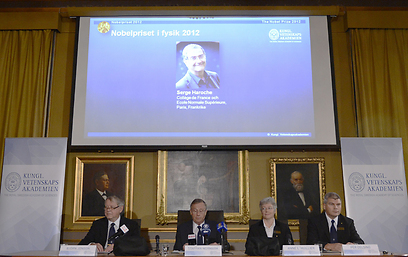French Jewish scientist Serge Haroche and American David Wineland opened the door to new experiments in quantum physics by showing how to observe individual quantum particles without destroying them.
A quantum particle is one that is isolated from everything else. In this situation, an atom or electron or photon takes on strange properties. It can be in two places at once, for example. It behaves in some ways like a wave. But these properties are instantly changed when it interacts with something else, such as when somebody observes it.
Working separately, the two scientists, both 68, developed "ingenious laboratory methods" that allowed them to manage and measure and control fragile quantum states, the Royal Swedish Academy of Sciences said.
"Their ground-breaking methods have enabled this field of research to take the very first steps towards building a new type of superfast computer based on quantum physics," the academy said. "The research has also led to the construction of extremely precise clocks that could become the future basis for a new standard of time."

'Ground-breaking research.' Winners announced (Photo: AFP)
Haroche is a professor at the College de France and Ecole Normale Superieure in Paris. Wineland is a physicist at the National Institute of Standards and Technology and the University of Colorado in Boulder, Colorado.
The two researchers use opposite approaches to examine, control and count quantum particles, the academy said.
Wineland traps ions – electrically charged atoms – and measures them with light, while Haroche controls and measures photons, or light particles.
'It was obvious that they were a package'
Haroche said he was out walking with his wife when he got the call from the Nobel judges.
"I was in the street and passing a bench so I was able to sit down," Haroche told a news conference in Stockholm by telephone. "It's very overwhelming."
He said his work in the realm of quantum physics could ultimately lead to unimaginably fast computers, with atoms that can essentially be in two different states at the same time.
"You can do things which are prohibited by the laws of classical physics," he told The Associated Press.
Christopher Monroe, who does similar work at the Joint Quantum Institute at the University of Maryland, said the awarding of the prize to the two men "is not a big surprise to me ... It was sort of obvious that they were a package."
Monroe said that thanks to the bizarre properties of the quantum world, when he and Wineland worked together in the 1990s, they were able to put a single atom in two places simultaneously.
At that time, it wasn't clear that trapping single atoms could help pave the way to superfast quantum computers, he said. That whole field "just fell into our laps,'" Monroe said.
The physics prize was the second of the 2012 Nobel Prizes to be announced, with the medicine award going Monday to stem cell pioneers John Gurdon of Britain and Japan's Shinya Yamanaka. Each award is worth 8 million kronor (about $1.2 million).
Only two women have won the physics prize since it was first awarded in 1901: Marie Curie in 1903 and Maria Goeppert-Mayer in 1963.
The prizes are always handed out on December 10, the anniversary of prize founder Alfred Nobel's death in 1896.















